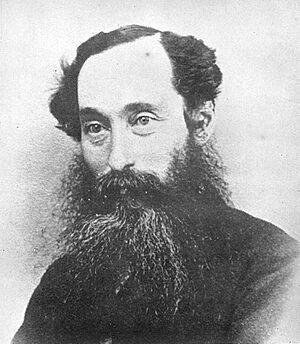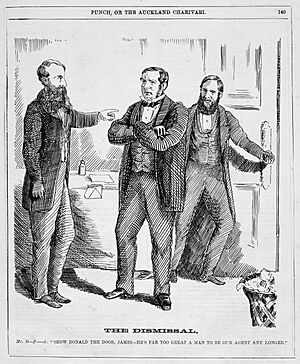Edward Stafford (politician) facts for kids
Quick facts for kids
Sir Edward Stafford
|
|
|---|---|
 |
|
| 3rd Premier of New Zealand | |
| In office 2 June 1856 – 12 July 1861 |
|
| Monarch | Victoria |
| Governor | Thomas Gore Browne |
| Preceded by | William Fox |
| Succeeded by | William Fox |
| In office 16 October 1865 – 28 June 1869 |
|
| Governor | George Grey |
| Preceded by | Frederick Weld |
| Succeeded by | William Fox |
| In office 10 September 1872 – 11 October 1872 |
|
| Governor | George Bowen |
| Preceded by | William Fox |
| Succeeded by | George Waterhouse |
| 6th Colonial Secretary | |
| In office 4 November 1856 – 12 July 1861 |
|
| Preceded by | William Richmond |
| Succeeded by | Isaac Featherston |
| 1st Superintendent of Nelson Province | |
| In office 1 August 1853 – September 1856 |
|
| Preceded by | Position established |
| Succeeded by | John Perry Robinson |
| Personal details | |
| Born |
Edward William Stafford
23 April 1819 Edinburgh, Scotland |
| Died | 15 February 1901 (aged 81) London, England |
| Political party | None |
| Spouses |
Emily Wakefield
(m. 1846; died 1857)Mary Bartley
(m. 1859; died 1899) |
| Children | 6 |
| Alma mater | Trinity College Dublin |
| Signature | |
Sir Edward William Stafford (born 23 April 1819, died 15 February 1901) was a very important leader in New Zealand's early history. He served as the country's third Premier (like a Prime Minister) three times in the mid-1800s. He held this top job for longer than any other leader who didn't belong to a political party. People described him as practical, logical, and very clear-thinking.
Contents
Early Life and Start in Politics
Edward William Stafford was born in Edinburgh, Scotland, on 23 April 1819. His family was wealthy, so he got a great education. He went to the Royal School Dungannon in Ireland and then to Trinity College Dublin.
In 1843, he moved to Nelson, New Zealand, where some of his relatives lived. He quickly became involved in politics. He spoke out against Governor Robert FitzRoy's handling of a conflict over land called the Wairau Affray. By 1850, he was one of many people calling for New Zealand to govern itself. He also supported the idea of "universal suffrage," which meant everyone should have the right to vote.
In 1853, Stafford became the first leader, or "Superintendent," of the Nelson Province. One of his biggest achievements was setting up an education system there. This system made school compulsory, free, and non-religious. It was so good that it later became the model for New Zealand's national education system. Many people thought he did a great job leading Nelson Province.
When the New Zealand Parliament first opened, Stafford didn't join right away. He felt it was wrong to be in national politics while still leading the province. However, after being asked by other politicians, he ran in the 1855 New Zealand general election and was elected as a Member of Parliament (MP) for Nelson.
Premier of New Zealand: Leading the Country
First Time as Premier (1856-1861)
When the job of Premier was created in 1856, Stafford didn't want it at first. Henry Sewell took the job, but his government lasted only 13 days! Then William Fox became Premier, but his government also lasted only 13 days. Since no one else seemed able to lead, Stafford finally agreed to become Premier. He was only 37 years old, making him the youngest person to become New Zealand's Premier.
One of Stafford's first actions was to clarify how the central government would work with the provincial governments. He also helped create the first unofficial "Cabinet." This was a group of ministers who met without the Governor. This meant that much of the government's work was done without the Governor's input, which sometimes caused tension between the Governor and Parliament.
Stafford often disagreed with Governor Thomas Gore Browne about who should control dealings with Māori. The Governor believed he should have control, but Stafford wanted Parliament to make those decisions. Stafford even refused to pay for actions the Governor took without Parliament's approval.
In 1858 and 1859, Stafford traveled outside New Zealand to negotiate for the country. While he was away, his colleagues and Governor Browne made a decision to force Māori to sell land at Waitara. Stafford strongly disagreed with this. This decision led to the First Taranaki War. Stafford felt this was wrong both financially and morally, and he thought about resigning. He decided to stay, but his views on Māori relations eventually led to his downfall. Other politicians, like William Fox, criticized Stafford for being "weak." Stafford also didn't support the Invasion of the Waikato, a major conflict. Because of this, he lost Parliament's support by just one vote in July 1861. William Fox then became Premier again.
Stafford had chances to become Premier again later, but he turned them down. He didn't want the job if the Governor would just block his plans.
Second Time as Premier (1865-1869)
On 16 October 1865, Stafford became Premier again. He continued the work of the previous Premier, Frederick Weld, but he also tried to reduce what he saw as too much spending. His government was known for being efficient and careful with money.
Stafford's relationship with the Governor became difficult again, especially over who should pay for the military actions against Māori during the New Zealand Wars. Stafford believed these conflicts were started by the British government, so Britain should pay. He refused to pay the high costs Britain demanded. In 1868, they finally agreed that both sides would drop their financial claims.
Stafford's government generally had good relations with Māori for a while. For example, in 1867, special Māori seats were created in Parliament. Stafford also asked the Governor to pardon Māori chiefs who had been involved in conflicts. However, when Māori leaders Te Kooti and Titokowaru had military successes, some people said Stafford's efforts to make peace were wrong. Stafford wanted to hold an election to get new support, but Governor George Bowen, who didn't like Stafford, blocked his request. Stafford's government was defeated in 1869, and William Fox became Premier once more.
Third Time as Premier (1872)
William Fox's government was increasingly led by its finance minister, Julius Vogel. Stafford started to focus his attention on Vogel. While Stafford didn't completely disagree with Vogel's big plans for public works (like building roads and railways), he thought Vogel was careless in how he carried them out.
Fox's control over his government weakened, which allowed Stafford to become Premier again in 1872. However, Stafford's support in Parliament was very small. He was soon defeated in a "vote of no confidence," meaning Parliament no longer trusted his leadership. With Governor Bowen again refusing an election, Stafford had to resign. George Waterhouse replaced him.
Stafford tried to unite the politicians who opposed the government, but it was too difficult. He then started to work with Julius Vogel. Even though Stafford had criticized Vogel's money plans, and Vogel had helped end Stafford's last time as Premier, they actually shared many similar ideas. When Vogel became Premier, he offered Stafford a job in his government, but Stafford said no because he needed to take care of personal matters.
Later Life
Stafford left his role as an MP for Nelson in 1868 and was elected as an MP for Timaru the next day. He stayed in that role until he retired from politics in 1878. He didn't like the new government led by former Governor George Grey.
After retiring, Stafford spent a lot of time in England, focusing on business. He was given a special honour, becoming a Knight Commander of the Order of St Michael and St George. He was also offered leadership roles in other parts of the British Empire, like Madras (now Chennai) and Queensland, but he turned them down. In 1887, he received an even higher honour, becoming a Knight Grand Cross of the Order of St Michael and St George.
Sir Edward Stafford died in London on 15 February 1901. He had three daughters and three sons with his second wife, Mary Bartley, who had passed away in 1899. His first wife, Emily Charlotte, had died in 1857 and they had no children. Interestingly, Stafford's life almost exactly matched that of Queen Victoria – he was born just 31 days before her in 1819 and died 24 days after her in 1901.
Images for kids



